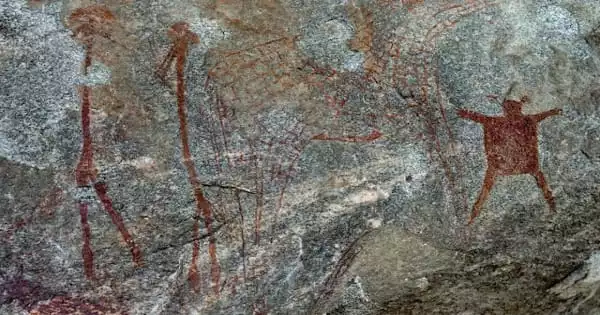A new analysis of human remains discovered in African archaeological sites has yielded the continent’s earliest DNA, revealing a fascinating story about how early humans lived, traveled, and even found their significant others.
The findings of an interdisciplinary team of 44 researchers were published in the paper “Ancient DNA reveals deep population structure in Sub-Saharan African foragers.” The study, published in Nature, reports findings from ancient DNA from six people buried between 18,000 and 5,000 years ago in Malawi, Tanzania, and Zambia.
“This more than doubles the antiquity of previously reported ancient DNA data from Sub-Saharan Africa,” said David Reich, a Harvard University professor and Howard Hughes Medical Institute investigator whose lab generated the data in the paper. “The study is especially exciting because it represents a truly equal collaboration of archaeologists and geneticists.”
The study also reanalyzed previously published data from 28 people buried across the continent, resulting in new and improved data for 15 of them. The end result was a previously unseen collection of DNA from ancient African foragers – people who hunted, gathered, or fished. Because of the many population movements and mixtures that have occurred in the last few thousand years, it is difficult to reconstruct their genetic legacy from modern people.
By associating archaeological artifacts with ancient DNA, the researchers have created a remarkable framework for exploring the prehistory of humans in Africa. This insight paves the way for a new understanding of humanity and our complex shared history.
John Yellen
Using this information, the researchers were able to map major demographic shifts that occurred between 80,000 and 20,000 years ago. People from various regions of the continent moved and settled in other areas as early as 50,000 years ago, forming alliances and networks over long distances to trade, share information, and even find reproductive partners. According to the researchers, this social network assisted them in surviving and thriving.
Elizabeth Sawchuk, one of the study’s authors and a Banting Postdoctoral Fellow at the University of Alberta as well as a research assistant professor at Stony Brook University, said that a dramatic cultural shift occurred during this time period, with beads, pigments, and other symbolic art becoming common across Africa. For a long time, researchers assumed that major changes in the archaeological record around 50,000 years ago reflected changes in social networks and possibly population size. These hypotheses, however, have proven difficult to test.
“Until now, we’ve never been able to directly investigate these proposed demographic shifts,” she explained. “It has been difficult to reconstruct events in our distant past using DNA from living people, and artifacts such as stone tools and beads cannot tell us the entire story. The missing piece of the puzzle was ancient DNA, which provides direct insight into the people themselves.”

There are arguments that the development and expansion of long-distance trade networks around this time helped humans weather the last Ice Age, according to Mary Prendergast, an author of the paper and associate professor of anthropology at Rice University. “Humans began to rely on each other in novel ways,” she explained. “And it’s possible that this creativity and innovation is what allowed people to thrive.”
The researchers were also able to show that people had stopped moving around as much around 20,000 years ago. “Perhaps it was because previously established social networks allowed for the flow of information and technologies without people having to move,” Sawchuk speculated.
According to Prendergast, the study provides a better understanding of how people moved and interacted in this region of Africa. Previously, the earliest African DNA was found in what is now Morocco, but the people in this study lived as far away from there as Bangladesh is from Norway, she explained.
“Our genetic study confirms an archaeological pattern of more local behavior in eastern Africa over time,” said Jessica Thompson, an assistant professor of anthropology at Yale University, one of the researchers who discovered the remains. “Initially, people found reproductive partners from diverse geographic and cultural backgrounds. Later, they prioritized partners who lived nearby and could be more culturally similar.”
Scholars from Canada, Kenya, Malawi, Tanzania, the United States, Zambia, and many other countries comprised the research team. Curators and co-authors from African museums who are in charge of protecting and preserving the remains made significant contributions to the study.
Potiphar Kaliba, director of research at the Malawi Department of Museums and Monuments and one of the study’s authors, noted that some of the skeletons sampled for the study were excavated more than a half-century ago, but their DNA has been preserved despite the tropics’ hot and humid climates.
“This work demonstrates why it is critical to invest in the care of human remains and archaeological artifacts in African museums,” Kaliba said. According to Prendergast, the work also contributes to addressing global imbalances in research.
“There are approximately 30 times more published ancient DNA sequences from Europe than from Africa,” she explained. “Given that Africa has the most human genetic diversity on the planet, we still have a lot to learn.”
“By associating archaeological artifacts with ancient DNA, the researchers have created a remarkable framework for exploring the prehistory of humans in Africa,” said John Yellen, program director of the Archaeology and Archaeometry program at the National Science Foundation, one of the project’s funders. “This insight paves the way for a new understanding of humanity and our complex shared history.”





